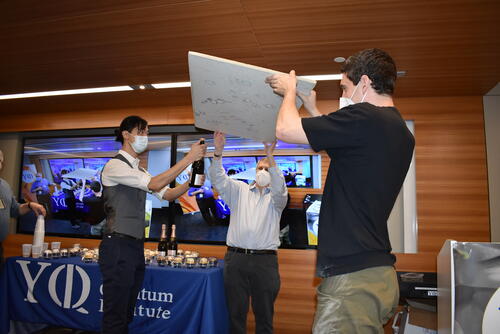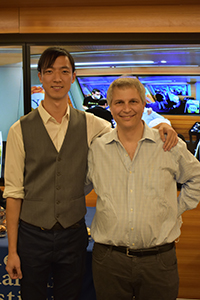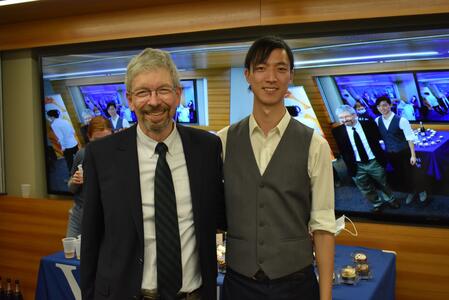
On March 7, 2022, Yale Physics graduate student Chris Wang successfully defended the thesis, “Bosonic quantum simulation in circuit quantum electrodynamics”. (Advisor: Rob Schoelkopf).
Wang explained, “Conventional quantum computers operate on quantum bits, or qubits, which can be in various superpositions of 0 and 1. My thesis work implements a small scale quantum processor that operates instead on bosonic modes, which can each support superpositions of many energy levels. Our processor manipulates microwave photons in an architecture known as circuit quantum electrodynamics to efficiently simulate molecular dynamics, where the nuclear motion is inherently bosonic. This work motivates the development of alternate quantum computing architectures that are specifically tailored to solve specific problems of interest that are challenging for classical computers, commonly referred to as analog quantum simulation.”
This fall, Wang will join the University of Chicago as a Grainger Postdoctoral Fellow.
Thesis Abstract:
The development of controllable quantum machines is largely motivated by a desire to simulate quantum systems beyond the capabilities of classical computers. For investigating intrinsically multi-level model bosonic systems, using conventional quantum processors based on two-level qubits is inefficient and incurs a potentially inhibitive mapping overhead in the current “near-intermediate scale quantum” (NISQ) era. This motivates the development of hybrid quantum processors that contain multiple types of degrees of freedom, such that one can leverage an optimal one-to-one mapping between the model system and simulator. Circuit quantum electrodynamics (cQED) has emerged as a leading platform for quantum information processing owing to the immense flexibility of engineering high fidelity coherent interactions and measurements. In cQED, microwave photons act as bosonic particles confined within a nonlinear network of electromagnetic modes. Controlling these photons serves the basis for a hardware efficient platform for simulation of naturally bosonic systems. In this thesis, we present two experiments that encapsulate this idea by simulating molecular dynamics in two different regimes of electronic-nuclear coupling: adiabatic and nonadiabatic. In the first experiment, we implement a boson sampling protocol for estimating Franck-Condon factors associated with adiabatic photoelectron spectra. Importantly, we fulfill the scalability requirement by developing a novel single-shot number-resolved detector for microwave photons. In the second experiment, we develop and employ a model for simulating dissipative nonadiabatic dynamics through a conical intersection as a basis for modeling photochemical reactions. We directly observe branching of a coherent wave-packet upon passage through the conical intersection, revealing the competition between coherent evolution and dissipation in this system. The tools developed for the experiments in this thesis serve as a basis for implementing more complex bosonic simulations.
Some photos from the defense:
 Chris Wang & Rob Schoelkopf |
|
